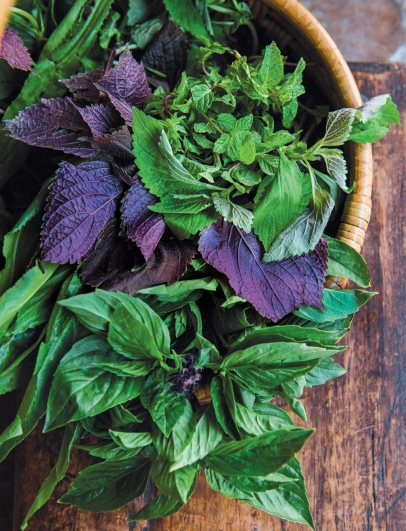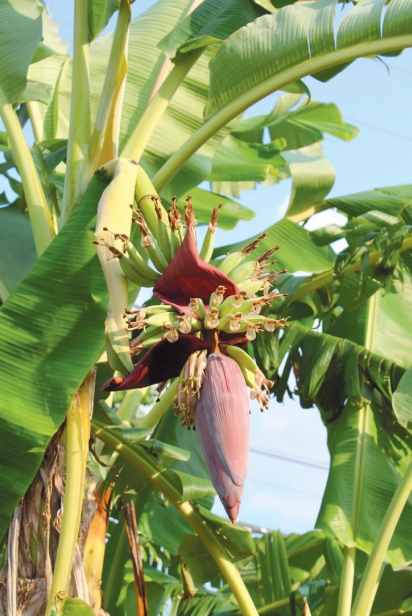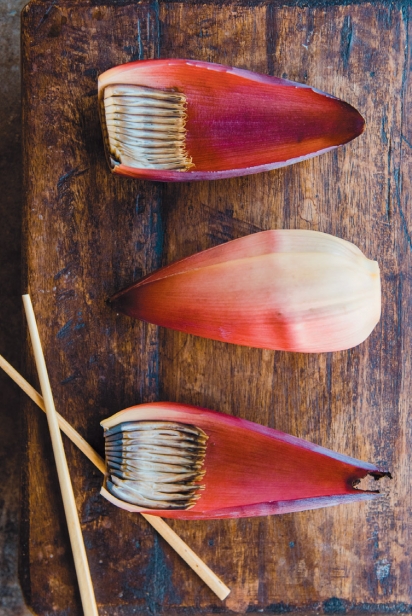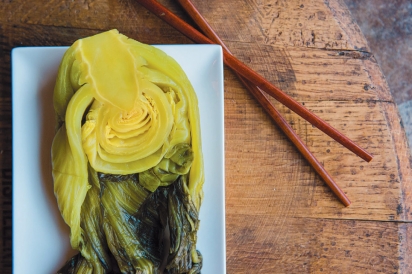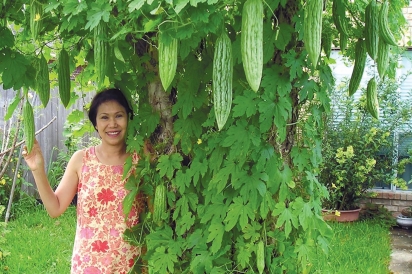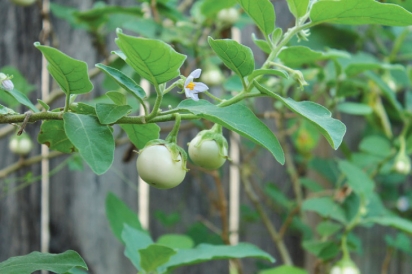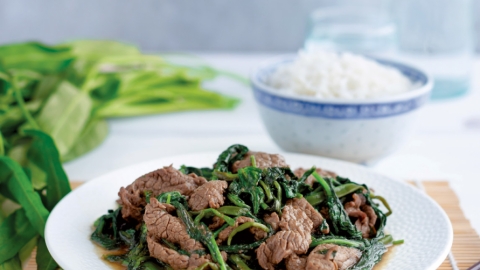Vietnamese Houstonians’ Home Gardens are a Sliver of Homeland
How Vietnamese Houstonians’ home gardens keep them connected to their culinary roots.
Recently, Việt Nam’s cuisine was named the world record holder in five categories: 1) most noodle dishes and broths; 2) most types of fish sauce and fish-sauce-related dishes; 3) most dishes made from flowers; 4) most special rolls; and 5) most dishes made from rice flour. These distinctions, jointly awarded by the World Record Association and the World Records Union, demonstrate the rich, diverse and complex food history of Việt Nam. After the tragic Việt Nam war, thousands of Vietnamese fled Communist rule in the post-war years and resettled in the United States and elsewhere. Many in the Vietnamese diaspora soon started reconnecting to those complex food roots by growing a diverse range of herbs, vegetables and fruit trees that were familiar and comforting.
Vietnamese Houstonians, like my parents, have continued that tradition of cultivating kitchen gardens. Whether it’s an entire backyard or a potted garden under a staircase, these kitchen gardens are a sliver of home away from their homeland, and they have become safe havens that evoke powerful memories of and connections to what Vietnamese cultivated, cooked and consumed in Việt Nam.
On foreign soil, the daily practice of cultivating food gives immigrants and refugees an opportunity to create a sense of rootedness on their own terms. They can shape their world by growing and cooking their own foods. Through this food sovereignty, immigrants and refugees not only regain some food security, but also their food heritage. For Vietnamese Houstonians, planting herbs, vegetables and fruit trees develops a culinary citizenship that preserves and expands Vietnamese cuisine for themselves while simultaneously enriching food culture in the United States. Vietnamese Americans nurture their food roots to live a more dignified life–even if that life does not completely escape the traumas of war, refuge, resettlement and marginalization. Rather, their food roots are emancipatory foodways that help redefine their lives as new Americans living beyond such haunting memories.
What They Grew in Việt Nam
Like many Vietnamese Houstonians, Nguyễn Văn Nam learned how to garden while growing up in Việt Nam, helping his mother in their front and backyards. Nguyễn reflects: “Back home in North Việt Nam, when I was little, my father was the only one working. My mother stayed home, taking care of the house, watching the children, going to the market nearby to get food, preparing the meals and working in the garden when she had time. We had a big backyard with fruit trees and a bigger frontyard for vegetables. When my sister and I came home from school, we tried to do our homework and study our lessons first. If we still had time, we went to the frontyard to help Mom. I learned from Mom how to use the shovel, hoe and rake. I also learned how to plant different kinds of vegetables and how to take care of them.”
Tammy Đình recollects her childhood home in Huế, Việt Nam, where she lived in a spacious residence with a huge garden and an abundance of farm animals: “My parents’ home was like a zoo. They cultivated a big garden. They had a farm full of animals: chickens, pigs, ducks, rabbits and more.” They also grew fruit trees such as papayas (đu đủ); small, sweet bananas (quả chuối ngọt); and sweetsops (m.ng cầu).
What They Grow in the Houston Area
Hoàng Son grew up in Pearland where his parents, Nguyễn Lan and Hoàng Quang, cultivated a spacious backyard. Son says:
“My dad grew all sorts of trees: pears, peaches, persimmons, etc. On the other hand, my mom did not take up planting until we moved off the land and into a Pearland subdivision. I guess to her, planting and managing a 7,000-square-foot lot is much easier than two acres. Since retirement, they have been planting and growing both decorative and practical gardens, each year improving on their techniques and craft. They were able to crossbreed the fruits and vegetables to achieve the sweetest kumquats and to graft plants to produce seedless oranges. Life in Pearland became home for both of my parents because they never imagined living elsewhere.”
Son’s mother, Lan, enjoys thinking of these beautiful plants as the product of her hard work and appreciates that the fresh produce strengthens and improves their health. His father, Quang, believes that gardening helps him remember the past and connects them with their life in Việt Nam. They both find gardening a nurturing daily activity that not only reduces stress but provides a connection to nature. Quang explains, “Gardening makes you live close to nature and makes life more beautiful!” Lan adds, “It’s also good for our relationship because it gives us things to do together.”
Despite the challenges of gardening in Houston’s heat and humidity, Nguyễn Văn Nam believes that gardening helps Vietnamese Americans maintain some of their traditions. “This is an effort to preserve and extend the traditions of our ancestors. The Vietnamese, when leaving their homeland, promised to themselves to preserve and to develop their traditions and culture.” My father, Vũ Kiến An Quân, believes that gardening gives them “a greater sense of our mother country.”
For Vietnamese Houstonians, their home gardens have given them the freedom to remember, rebuild and reconnect with their Vietnamese culture. They have transitioned from living in refuge to living in resistance; a resistance to a dominant food culture that was alien to them. Their work with the soil has provided ingredients that are elemental to Vietnamese food culture. With them they cook comforting meals for their families that also introduce their neighbors to a rich and diverse cuisine that is vital to Vietnamese Houstonians’ survival, wellness and identity.
Meals with Homegrown Ingredients
Both of my parents, Vũ Kiến An Quân and Trần Thị Diem Dũng, have a passion for gardening. They have cultivated a home garden in their front and backyards for decades. In recent years, they have focused on growing đậu bắp (okra), cà pháo (white eggplants) and chuối (bananas). During each harvest, they cut the okra into bite-size pieces so that my mother can make canh chua (sour soup) with steamed catfish and chopped pineapples. They pickle the white eggplant in jars, then use them as a condiment, sometimes mixing the fermented eggplant with fish sauce to enhance the flavors and create a dip for other foods. Vietnamese love short, plump and well-ripened bananas, and my parents are no exception. They eat them as a snack. When overripe, the bananas are sometimes used to make bánh chuối chiên (fried banana pancakes). James Beard Award–winning author and food scholar Andrea Nguyễn wrote in Into the Vietnamese Kitchen: Treasured Foodways, Modern Flavors, “The Vietnamese adore bananas, arguably the country’s national fruit. Many kinds–small, large, scrubby, sweet, starchy–are available, and people know the seasonal and regional differences. A giant herb related to lilies and orchids, the entire banana plant (leaves, fruits, blossoms, trunk, and roots) is used in cooking.”
My mother handpicks her favorite greens, rau đay (jute leaves), to cook a refreshing and healthy pot of canh rau đay (jute leaf soup). My parents plant tía tô (perilla), rau muống (water spinach), ớt (Thai chili peppers), rau thơm (mints) and other herbs. They use the perilla, mint leaves and water spinach as garnishes for phở, bún and other hot soups. Thai chili peppers are added to a bowl of fish sauce or eaten separately as a condiment. In past years, they grew bí đao (winter melons) and mướp (luffas). The winter melons would be cut into small pieces to make canh bí (winter melon soup), while the luffas are sliced into thin, bite-sized pieces to make canh mướp (luffa soup). My mother uses homegrown herbs as garnishes and condiments for many traditional Vietnamese dishes such as cây me chua (sorrel) for phở and rau thơm for bún riêu (crab-based egg soup with noodles). She pickles mustard greens to make dưa cải chua (pickled mustard greens) that are accompaniments to many meals.
For Vietnamese Houstonians, the herbs, vegetables and fruit trees grown in their yards are critical for preparing traditional Vietnamese dishes and sauces and for preserving the flavors, tastes, textures and smells of the food they consumed when they were living in Việt Nam. Even with limited resources and land for their home gardens, they have created spaces where they can achieve food sovereignty, remember their homeland and establish culinary citizenship. They are preserving and expanding Vietnamese foodways while introducing them to the non- Vietnamese populace. Their home gardens are not proverbial “Garden of Edens,” they are more–they are home.
Notes: The Vietnamese names quoted in this article use Vietnamese formality, meaning the person’s last name is stated first, followed by the middle name, and finally the first name. Some quotes from interviews conducted by Roy Vũ also appeared in Feasted Landscapes: Sustainability in American Topics, Volume 1, by Lori Delacruz Lewis, Brandon Morton, Yolanda Romero and Roy Vũ, published by Kendall Hunt, 2018.


